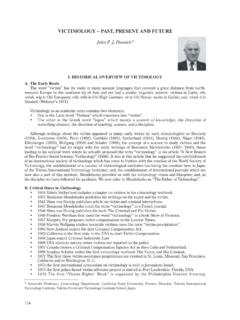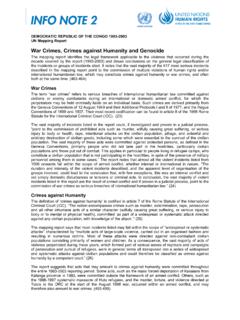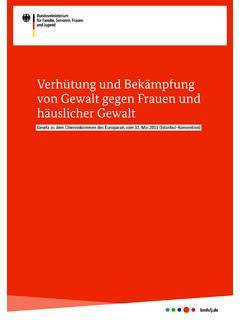Transcription of Chapter 13 THE RIGHT TO EQUALITY OF JUSTICE
1 Chapter 13 THE RIGHT TO EQUALITYAND NON-DISCRIMINATIONIN THE ADMINISTRATIONOF ObjectiveslTo familiarize the participants with the notion of EQUALITY before the law and theprinciple of non-discrimination as understood by international human rights illustrate how these principles are being applied in practice at the universal andregional identify some groups that may be particularly vulnerable to explain what legal steps, measures and/or actions judges, prosecutors and lawyersmust take in order to safeguard the notion of EQUALITY before the law and the principleof would you define discrimination and/or inequality of treatment?lHow is the notion of EQUALITY before the law and the principle of non-discriminationprotected in the country in which you work?
2 LHave you ever been faced with cases of discrimination in your professional life?lAre there any particularly vulnerable groups in the country in which you work?lIf so, who are they and how are they discriminated against?lIn the country in which you work, are there any particular problems of discriminationon the basis of gender?lIf so, what are they?lWhat measures can you take as a legal professional to protect everybody s RIGHT toequality before the law and to ensure the RIGHT of individuals and groups not to besubjected to discrimination?Human Rights in the Administration of JUSTICE : A Manual on Human Rights for Judges, Prosecutors and Lawyers631 Relevant Legal InstrumentsUniversal InstrumentslCharter of the United Nations, 1945lInternational Covenant on Civil and Political Rights, 1966lInternational Covenant on Economic, Social and Cultural Rights, 1966lInternational Convention on the Elimination of All Forms of RacialDiscrimination, 1965lConvention on the Elimination of All Forms of Discrimination againstWomen, 1979lConvention on the Rights of the Child, 1989lStatute of the international Tribunal for the Former Yugoslavia, 1993lStatute of the international Tribunal for Rwanda, 1994lRome Statute of the international criminal Court.
3 1998lThe Four Geneva Conventions of 12 August 1949lThe 1977 Protocols Additional to the Geneva Conventions of 12 August 19491**lUniversal Declaration of Human Rights, 1948lDeclaration on the Elimination of All Forms of Intolerance and ofDiscrimination based on Religion or Belief, 1981lDeclaration on the Rights of Persons Belonging to National or Ethnic,Religious and Linguistic Minorities, 1992 Regional InstrumentslAfrican Charter on Human and Peoples Rights, 1981lAfrican Charter on the Rights and Welfare of the Child, 1990lAmerican Convention on Human Rights, 1969lInter-American Convention on the Prevention, Punishment, andEradication of Violence against Women, 1994lInter-American Convention on the Elimination of All Forms ofDiscrimination against Persons with Disabilities, 1999lEuropean Convention on Human Rights, 1950lEuropean Social Charter, 1961, and European Social Charter (Revised),1996lFramework Convention for the Protection of National Minorities,1995632 Human Rights in the Administration of JUSTICE : A Manual on Human Rights for Judges, Prosecutors and LawyersChapter 13 The RIGHT to EQUALITY and Non-Discrimination in the Administration of Justice1 For more legal instruments relating to discrimination, seeTrainers Guide,Annex II Handout No.
4 Discrimination: A persistent serious human rightsviolationIn spite of unprecedented progress at the international level in enhancing thelegal protection of individuals and groups of individuals against discrimination, reportsfrom all parts of the world confirm the fact that discriminatory acts and practices areanything but a memory from the past. Discrimination is multifaceted and present notonly in State or public structures but also in civil society in general. To a greater or lesserextent, discrimination may thus affect the way people are treated in all spheres ofsociety such as politics, education, employment, social and medical services, housing,the penitentiary system, law enforcement and the administration of JUSTICE in may have many different causes and may affect people ofdifferent racial, ethnic, national or social origin such as communities of Asian orAfrican origin, Roma, indigenous peoples, Aborigines and people belonging todifferent castes.
5 It can also be aimed at people of different cultural, linguistic orreligious origin, persons with disabilities or the elderly and, for instance, persons livingwith the HIV virus or with AIDS. Further, persons may be discriminated againstbecause of their sexual orientation or based on gender is also commonplace in spite of the progressmade in many countries. Laws still exist which, inter alia, deny women the RIGHT torepresent matrimonial property, the RIGHT to inherit on an equal footing with men, andthe RIGHT to work and travel without the permission of their husbands. Women are alsoparticularly prone to violent and abusive practices, which continue unabated in manycountries, and they thus often suffer double discrimination, both because of their raceor origin and because they are major problem in today s world is also the discrimination to whichnumerous people, especially women and children, are subjected because they live inpoverty or extreme poverty.
6 These circumstances may force them to migrate and havecontributed to an increase in trafficking in persons, particularly women and children,who are also frequently subjected to physical restraint, violence and European countries in particular have in recent years experienced adisturbing increase in racist and xenophobic attacks on asylum-seekers and foreignersin general by neo-Nazi and other groups composed mainly of young people. However,such attacks have been perpetrated not only on persons of foreign origin but also onthose who dare to challenge the rightfulness of the acts committed by the groupsconcerned and the discriminatory or supremacist philosophy that they represent.
7 Suchphilosophies and other grounds for discriminatory treatment are among the root causesof the tragic upsurge, during the last decade, in flows of refugees and internallydisplaced Rights in the Administration of JUSTICE : A Manual on Human Rights for Judges, Prosecutors and Lawyers633 Chapter 13 The RIGHT to EQUALITY and Non-Discrimination in the Administration of JusticeAs shown by the World Conference against Racism in Durban, South Africa,in 2001, the challenge facing Governments, non-governmental organizations and civilsociety in stemming the tide of discrimination is considerable and requires serious,effective and concerted efforts by all The role of judges, prosecutors and lawyers inprotecting persons against discriminationJudges, prosecutors and lawyers naturally have an essential role to play inprotecting persons against discrimination.
8 Their task is to see to it that existing laws andregulations prohibiting discrimination are respected in legal practice. In some countriesdiscrimination is forbidden de jure but the laws are not adequately enforced. Judges,prosecutors and lawyers play a crucial role in remedying these situations and ensuringthat impunity for discriminatory acts is not tolerated, that such acts are duly investigatedand punished, and that the victims have effective remedies at their situations in which the domestic law on discrimination is non-existent orlacking in clarity, the legal professions may turn to international legal instruments forguidance, including, in particular, the relatively rich existing case law, parts of which willbe reviewed Glimpses of international legal historyThe RIGHT to EQUALITY and non-discrimination was not easily accepted by theinternational community.
9 During the 1919 Paris Conference, held in the aftermath ofthe First World War, Japan worked intensively to have the principle of racial equalityinserted in the Covenant of the League of Nations. Although a majority of eleven out ofseventeen members of the Conference Commission voted in favour of the Japaneseproposal, President Wilson of the United States suddenly declared from the chair thatthe amendment had failed . In spite of vigorous protests by several delegates againstthis rejection of the amendment, President Wilson insisted to the greatdisappointment of the Japanese delegation that the amendment had not , the League Covenant did not even contain any express reference tothe principle of EQUALITY between was made, however, during the elaboration of the Charter of theUnited Nations after yet another global war of unspeakable horror which had its originin deliberate and carefully systematized discriminatory practices embracing entire Statestructures.
10 The world could no longer close its eyes to such vile practices and the threatto peace that they Rights in the Administration of JUSTICE : A Manual on Human Rights for Judges, Prosecutors and LawyersChapter 13 The RIGHT to EQUALITY and Non-Discrimination in the Administration of Justice2 Paul Gordon Lauren,Power and Prejudice The Politics and Diplomacy of Racial Discrimination,2ndedn. (Boulder/Oxford, WestviewPress), pp. 99-100, and, in general on the issue of racial discrimination, Chapter 3 on Racial EQUALITY Requested and Rejected .3 See Keba Mbaye, ARTICLE 2, Paragraph 1 ,La Charte des Nations Unies Commentaire article par article,2ndedn, Jean-Pierre Cotand Alain Pellet, eds.
















